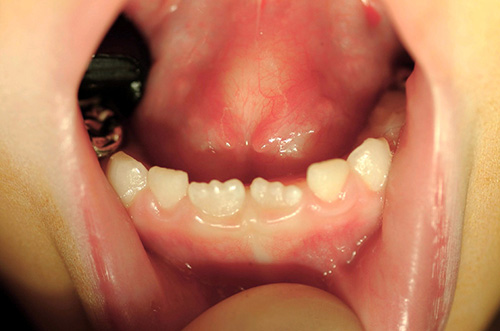Return to Case of the Month Archives
Single smooth surfaced and well-demarcated nodule, floor of mouth
Dolphine Oda, BDS, MSc
doda@u.washington.edu
Contributed by
Drs. Erich Naumann & Mark Egbert
Seattle Children’s Hospital, WA
Case Summary and Diagnostic Information

This is a healthy six-year-old boy with a single asymptomatic, smooth-surfaced, dome-shaped exophytic nodule on the floor of the mouth referred to as “sublingual ranula”.
Diagnostic Information Available
This is a healthy six-year-old boy with a single asymptomatic, smooth-surfaced, dome-shaped exophytic nodule on the floor of the mouth referred to as “sublingual ranula” (Fig 1). Identified during a routine examination by a pediatric general dentist, the lesion is of unknown duration. It is about 1.5 cm in greatest dimensions and is opalescent, white in color and spherical in shape. It is soft in consistency.

Figure 1. This is a clinical photograph as the patient first presented to the Children’s Hospital Dental Clinic. Note the large, smooth surfaced, dome-shaped exophytic nodule on the floor of mouth.
His past medical history is significant for asthma. He has no known allergies and is not on any medications.
This was a dome shaped and smooth surfaced lesion of 1.5 cm size in the midline anterior floor of mouth (Fig 1). It was soft in consistency and opalescent white in color, and it displaced the tongue upward. The patient reports no symptoms of dysphagia, dysphonia, and dyspnea.

Figure 1. This is a clinical photograph as the patient first presented to the Children’s Hospital Dental Clinic. Note the large, smooth surfaced, dome-shaped exophytic nodule on the floor of mouth.
The histology was diagnosed by Dr. Raj Kapur, Seattle Children’s Hospital, Department of Pathology. Histologic evaluation revealed a cystic structure lined by thin and keratinized epithelium (Fig 3) and filled with layers of keratin. The wall of the cyst contained sebaceous glands and occasional hair follicle.

Figure 3. This is a gross photograph of the nodule after it was removed from the floor of mouth. It is whitish-yellow in color.

Figure 5. Low power (x100) histology shows a cystic structure lined by orthokeratin with a granular cell layer underneath and supported by a thin fibrous connective tissue wall. The lumen is filled with keratin.

Figure 6. High power (x200) histology shows a closer look of the connective tissue wall containing sebaceous glands.
After you have finished reviewing the available diagnostic information